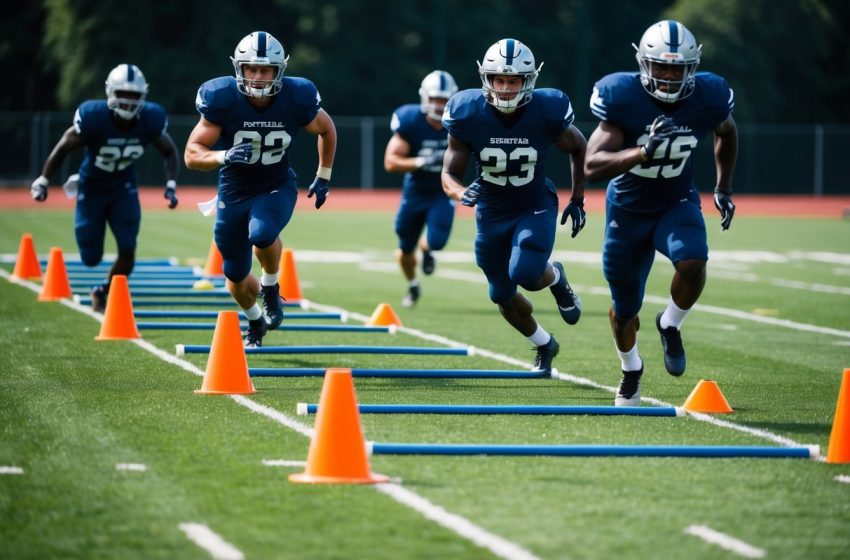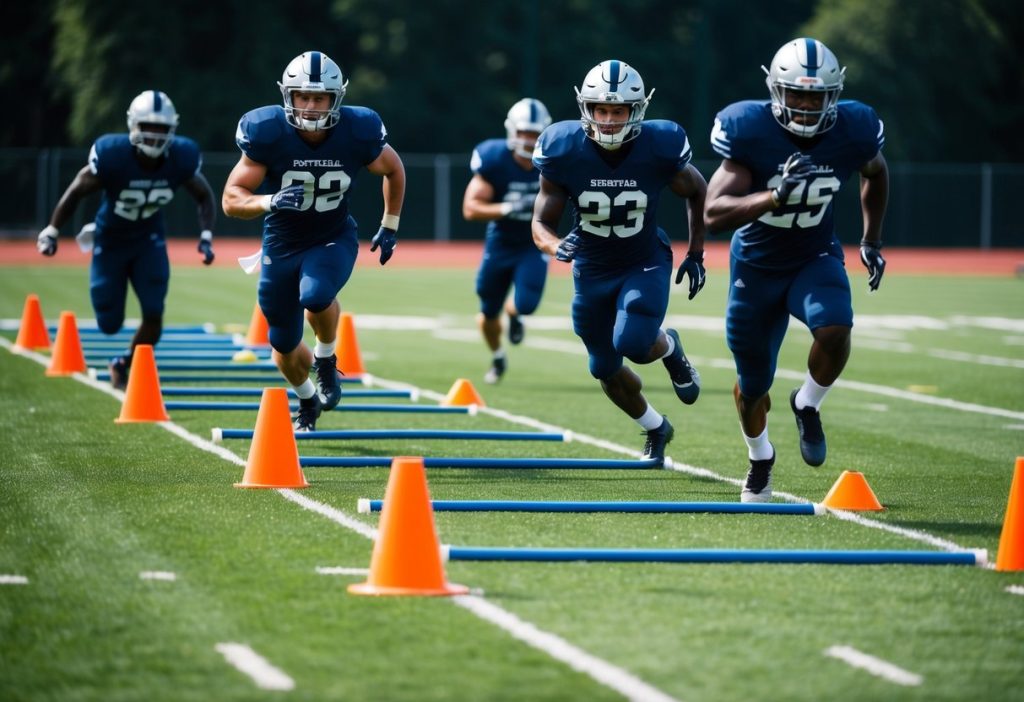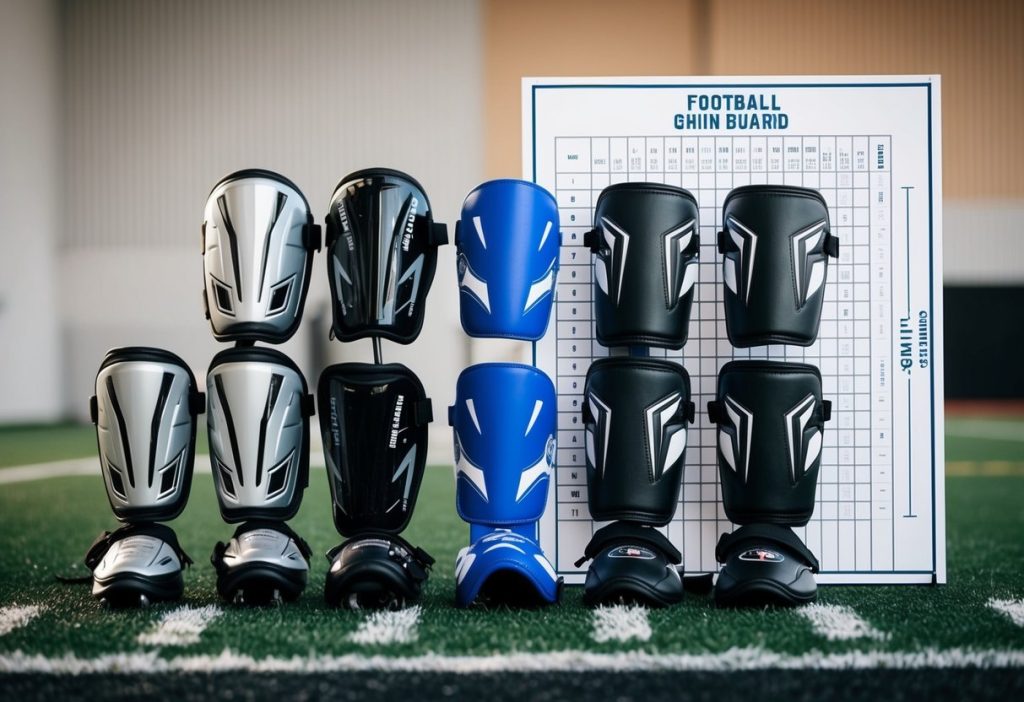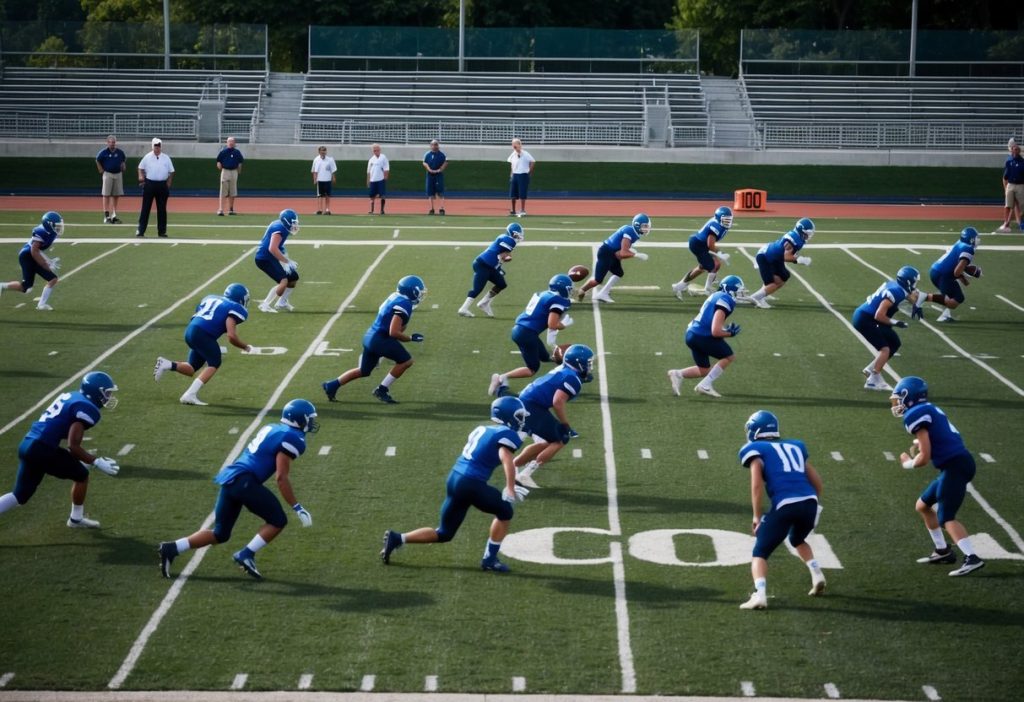Football Preseason Conditioning Plan

Football Preseason Conditioning Plan: Building Strength and Endurance for a Winning Season
Getting ready for football season means more than just showing up to play. The preseason is when you start laying the foundation for strength, speed, and endurance. A good football preseason conditioning plan prepares your body to handle the pace and demands of the game, helping you perform better and reduce your risk of injuries.

You’ll want to focus on whole-body workouts with exercises like squats, sprints, and mobility drills. Mixing in rest and stretches keeps you flexible and ready for each practice. When you train the right way now, you set yourself up for a smoother, safer, and more successful football season.
Key Principles of Football Preseason Conditioning

Football preseason conditioning prepares you for the physical and mental demands of the season ahead. With the right plan, you build fitness, help prevent injuries, and learn when to push and when to rest.
Goals of Preseason Training
The main goal of pre-season training is to get your body ready for games. You focus on increasing endurance, building strength, and improving your speed. Each week, the intensity should gradually rise. This helps your muscles and lungs adjust safely.
You also spend time on football-specific drills. These might include running with the ball, passing, and agility exercises. Repetition of these skills brings your technique back after a break.
Small-sided games and scrimmages are key in pre-season. They build teamwork and allow new players to learn the team’s style. Coaches track your performance, looking for both progress and areas that need more work.
Balancing Rest and Recovery
Rest is as important as training. Without proper rest, your body cannot recover from tough workouts. After intense sessions, you need time to let your muscles heal and grow stronger.
It helps to use a schedule that includes rest days and lighter workouts. Good sleep matters too. If you stay up late, your body doesn’t recover as well.
Ways to improve recovery:
- Hydrate after workouts
- Stretch and use foam rollers
- Eat balanced meals with protein and carbs
- Get at least 7-9 hours of sleep
If you listen to your body and rest when needed, you set yourself up for better performance.
Injury Prevention Strategies
Injury prevention is a must during the pre-season. You start by warming up before every session. Simple dynamic stretches get blood flowing and prepare your muscles.
Strength training also helps prevent injuries. Focus on key areas such as your knees, ankles, and hamstrings. Coaches may use balance drills or resistance bands to make joints more stable.
You should always speak up if you feel pain. Don’t hide minor injuries; they can get worse fast. Wearing proper gear and shoes is important too. Use ice or see a trainer if you notice any swelling or discomfort.
Essential Components of a Conditioning Plan

A well-structured preseason football conditioning plan focuses on preparing your body for training and competition. Staying consistent with routines helps improve performance and lowers the chance of injuries.
Warm-Up Routines
Before any intense physical activity, it’s important to get your body ready. Warm-up routines boost blood flow to your muscles and raise your heart rate. This helps you move better and reduces muscle stiffness.
A football warm-up often begins with light jogging or skipping for 5 to 10 minutes. You can then add dynamic drills, such as high knees, butt kicks, and arm circles. These movements mimic what you’ll do during practice.
Doing warm-ups as a team helps build focus and teamwork. It’s best to avoid static stretches at the start; save those for later. The main goal is to loosen up your whole body and mentally prepare for what’s next.
Stretching and Flexibility
Stretching is needed to improve flexibility and prevent muscle strains. There are two main types: dynamic stretching before workouts and static stretching after. Dynamic stretches, like walking lunges or leg swings, help prepare your muscles for action.
After your session, static stretching helps muscles relax and lengthen. Hold stretches such as hamstring or quad stretches for about 20-30 seconds each. Focus on all major muscle groups, but pay extra attention to the legs and lower back.
Regular stretching helps football players move more freely and keeps the muscles balanced. Flexible muscles help you turn, sprint, and change direction quickly, which are all key in football.
Fitness Testing and Assessment
Fitness tests show where you stand at the start of preseason. These tests may check your endurance, speed, strength, and agility. Some popular tests include the beep test, 40-yard dash, vertical jump, and push-up test.
A table can help keep track of your results:
| Test | Purpose | Frequency |
|---|---|---|
| Beep Test | Endurance | Start, mid, end |
| 40-Yard Dash | Speed | Every 2-3 weeks |
| Vertical Jump | Power | Every 2-3 weeks |
| Push-Up Test | Strength | Every 2-3 weeks |
Tracking your scores helps you and your coaches see your progress. You can find out which areas need more work and adjust your plan if needed. This way, you target your training for the best results.
Building Endurance and Aerobic Capacity

To get ready for football season, you need a strong base of aerobic endurance. This means training your body to run for longer periods and recover quickly during games.
Jogging and Steady Pace Work
Jogging at a steady pace is your starting point for endurance. Aim for runs between 20 and 40 minutes, keeping your pace even and comfortable. A speed where you can still talk is a good guide—this trains your aerobic system without wearing you out.
Focus on maintaining a consistent pace. This helps raise your aerobic threshold, so your body uses oxygen more efficiently. Try running on grass or a field to reduce stress on your legs. Begin with three sessions per week.
Here’s a simple example:
| Day | Activity | Time |
|---|---|---|
| Monday | Jog (steady) | 30 min |
| Wednesday | Jog (steady) | 25 min |
| Saturday | Jog (steady) | 35 min |
Warming up and cooling down with light stretching can prevent injury and ease muscle tightness.
Interval Running Sessions
Interval running is key for building conditioning specific to football. You alternate between periods of fast running and slower jogging or rest. This helps your body handle the bursts of speed and quick recovery needed in matches.
A common session includes using 60-second runs at high effort (around 80–90% max pace), then 60 seconds of light jogging. Repeat this 8–10 times. This mix trains both your aerobic and lactic systems.
Keep intervals sharp but controlled—avoid sprinting all-out to stay in the right training zone. Use a stopwatch or smartphone timer to track each rep and rest. Space these workouts with a day of rest or lighter activity in between to help with recovery.
Developing Speed and Agility

Improving your speed and agility is key for success in football. You’ll need to focus on exercises that boost quickness, train your heart to handle intense workouts, and fine-tune your footwork for better performance on the field.
Sprint Drills
Sprint drills help you become faster over short and long distances. Start with basic sprints, like running 20-yard, 40-yard, or 60-yard dashes at full effort.
Try to rest one or two minutes between each sprint to let your heart rate recover. This keeps your speed high throughout the workout. Track your times to measure progress each week.
Mix things up with interval sprints—run for 15 seconds at top speed, then jog or walk for 30 seconds. Repeat this set 8–10 times. These intervals increase your speed and build stamina.
It’s important to warm up with three to five minutes of jogging and stretching before you start. This lowers your risk of injury and makes your muscles work better.
Ladder and Agility Training
Ladder drills help your feet move faster and improve coordination. Use an agility ladder placed flat on the ground. Move through the ladder using different patterns, like single-leg hops, in-and-out steps, or lateral shuffles.
Below is a simple example of ladder patterns you can try:
| Drill Name | How To Do It | Sets/Reps |
|---|---|---|
| One-Foot In | Step one foot per box | 3 sets of 10 |
| Two-Feet In | Both feet in each box | 3 sets of 10 |
| Lateral Shuffle | Side-step down the ladder | 3 sets of 8 |
Keep your knees bent and your body low in a strong athletic stance. This position helps you move faster and with better balance. Go as quickly as possible while staying in control.
Agility training can also include cone drills, zig-zag runs, and sudden direction changes. These techniques teach you how to react and move quickly, raising your overall game performance.
Strength and Functional Movement
Building real strength and movement skills helps you move better on the football field. You need to balance strength, flexibility, and endurance to get in top shape.
Circuit and Bodyweight Exercises
Circuits mix different exercises together so your body faces new challenges. In a typical football preseason circuit, you might do 30 seconds each of squats, planks, mountain climbers, and jumping jacks. Short rests keep your heart rate up and make the workout tougher.
Bodyweight moves like burpees, squat jumps, and planks build both strength and conditioning. You don’t need a lot of equipment to do these, which makes them easy to fit into any training plan.
You can create a simple circuit with this routine:
| Exercise | Time | Rest |
|---|---|---|
| Jump Squats | 30 sec | 15 sec |
| Push-Ups | 30 sec | 15 sec |
| Planks | 30 sec | 15 sec |
| High Knees | 30 sec | 15 sec |
Repeat the whole circuit 2–4 times depending on your fitness level.
Lunges and Push-Ups
Lunges work your legs, hips, and balance, which helps with cutting and sprinting on the field. Doing forward, reverse, and side lunges builds strength in different muscles. For football, it also helps protect your knees.
Push-ups train your chest, shoulders, and arms. They also build core strength when done with good form. To make them harder, try decline push-ups or add a clap at the top.
Sample lunge and push-up set:
- 10 Forward Lunges (each leg)
- 10 Reverse Lunges (each leg)
- 15 Push-Ups
- Rest 60 seconds, repeat 2–3 times
Changing your lunge angles and push-up style keeps the workout fresh.
Integrating Yoga for Mobility
Yoga helps your body stay flexible and recover from hard training. It also makes your muscles and joints move smoothly, lowering your risk of injury.
Simple yoga poses like downward dog, cobra, and warrior can stretch tight muscles after football drills. Regular yoga practice helps with balance, too, which is important for staying on your feet during games.
Try adding 10 minutes of yoga stretches at the end of your workout. Focus on slow, deep breaths and holding each pose for at least 20 seconds. This keeps your muscles loose and helps you recover faster for the next session.
Transition to the In-Season Phase
Starting the in-season phase after pre-season training is important for keeping your fitness and avoiding injuries. You have to balance staying strong with not tiring yourself out before games.
Maintaining Preseason Gains
You worked hard in pre-season, so keeping those gains is key. During the in-season phase, the goal is to hold onto the muscle, power, and speed you built without risking burnout.
Plan to do strength workouts about two times per week. These sessions can be shorter but should focus on full-body exercises like squats, lunges, and push-ups. This helps keep your muscles active and strong.
Include light sprints and agility drills to keep your reaction time and game speed sharp. Rest is also important, so watch for signs of fatigue and adjust if needed.
A weekly plan might look like this:
| Day | Activity |
|---|---|
| Monday | Recovery / Light Run |
| Tuesday | Strength Training |
| Thursday | Speed/Agility Work |
| Saturday | Light Strength Work |
| Sunday | Match/Game Day |
Adjusting Training Intensity
You need to shift the intensity of your workouts as you move into the in-season phase. Training should match your game schedule. Avoid heavy workouts right before a game to stay fresh.
Make your hardest workouts fall earlier in the week so your body can recover before game day. Use medium loads on weights and slightly cut back on the number of sets and reps compared to pre-season.
Take advantage of lighter sessions, like stretching or low-impact cardio, the day before and after matches. This helps with recovery and lowers your risk of injuries. Listen to your body and talk with your coach if you feel run-down. Adjust as needed for your level of play and game demands.
Frequently Asked Questions
Conditioning for football and soccer pre-season means focusing on strength, speed, and stamina. The right plan helps you avoid injuries and perform your best when games begin.
What are the essential components of a football pre-season training program?
You need strength training, speed drills, agility work, and aerobic conditioning. Core training and flexibility also help prepare your body. Don’t forget rest days—they allow your muscles to recover.
How can I improve my explosive speed for youth football during the off-season?
Include short sprints, plyometric exercises like box jumps, and ladder drills. Proper warm-ups and cool-downs keep your muscles safe. Stick to a routine that trains both your legs and your reaction time.
What is an effective structure for a high school football pre-season conditioning regimen?
Plan for 4 to 6 weeks of training. Start with basic conditioning, then add more football-specific drills each week. Mix running, weightlifting, and practice games, and follow a clear schedule.
How should I train in the 6 weeks leading up to football pre-season?
Each week, slowly increase your workout intensity. Mix in sprints, strength training, and agility drills. Try running different distances and doing workouts that challenge your endurance and speed.
What does a comprehensive 8-week soccer pre-season training plan entail?
Begin with base fitness and simple ball work. Add strength and power exercises in weeks 3 and 4. In the final weeks, focus on match fitness and playing at game speed. Make time for rest and stretching after tough sessions.
Can you suggest a 4-week progressive training plan for soccer pre-season?
Week 1: Focus on easy running and light technical drills.
Week 2: Add interval runs and strength exercises.
Week 3: Increase intensity, include small-sided games, and more sprint work.
Week 4: Practice at near-match pace, focus on tactics, and keep strength training steady.





